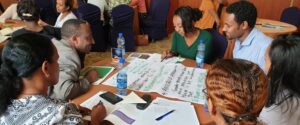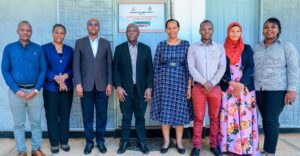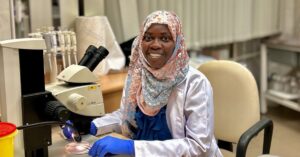INASP from the outside in
I almost dread being asked what INASP does – it’s hard to explain without going into massive amounts of detail about things which are not high on most people’s agendas, or about which a lot of people know very little. That is not meant to sound patronising – before I started working at INASP, I didn’t have much idea about research, higher education, and libraries either!
Communicating what we do at INASP to an audience that might not know the ins and outs of research is something we’ve struggled with and we’re always looking for that elusive short description which is pithy, captures the breadth of our work and doesn’t get bogged down in loads of detail. It’s always interesting when I hear my INASP colleagues describing our work – what they focus on, how they present it, what language they use. It’s amazing how many different ways our work can be presented.
What is even more interesting, and tells us a lot about how well we are communicating with different audiences, is hearing how others describe INASP’s work. Our full name (which we’ve kind of left behind with our new branding) sometimes limited the willingness of people to listen beyond the work we’ve done as an access initiative – negotiating with publishers for highly discounted subscriptions to high quality electronic research resources. There is so much more to INASP than this! I remember a few years ago finding myself next to someone high up at a development organisation while at a conference. Someone introduced us and he asked me what INASP was – I spelled out what the name was and his response was ‘Ah, access to journals’ and as I tried to continue, extolling the virtues of all the other aspects to our work, he turned away – he thought he’d got the measure of us and that was that.
Over the past few months, we have been lucky to host Dr Cristóbal Urbano, a Library and Information Science lecturer from the University of Barcelona (who is in fact an all-round library and research knowledge supremo!) as he took a sabbatical. Cristóbal’s time with us proved extremely fruitful, particularly when it came to our work in Latin America.
It was a great time to have him with us as we were preparing for and then embarking on our latest programme: Strengthening Research and Knowledge Systems (SRKS). Hearing the way Cristóbal described SRKS when he was on country visits showed that we had managed to communicate to him what it was all about. On his return to Barcelona, he wrote a post for the University of Barcelona blog (available in Spanish and Catalan) and it’s great to see the points that Cristóbal picked up on while he was here and how all of this sits within the wider context. I particularly like his concluding paragraph (translated rather roughly by me!):
“In summary, we can conclude that real knowledge mobilisation depends on the human factor and their determination to take part in their own development. So INASP’s new programme SRKS emphasises the need to promote local leadership in supporting the creation and use of scientific information. It is a strategy based on strengthening academic and research library consortia, but including a variety of actors involved in scientific research systems, those responsible for university policies, and the political authorities of each country.”
Couldn’t have put it better myself… INASP is all about working with countries to strengthen what is already in place, not setting up parallel structures that are dependent on outside support and therefore potentially unsustainable in the long-term. We work with some truly inspirational people whose personal commitment to ensuring that research is available, accessed, used, published, made visible is what drives this work forward – it’s the human factor that Cristóbal mentions.
So back to what I was saying about communicating what we do – all we need now is for people to spend 6 months with us and then they’ll develop a true understanding of all we do 🙂 Hmm, maybe not the most realistic basis for a comms strategy…
But what could be taken from this ‘immersion in the organisation’ approach and made to work in a more manageable way, to inform our communications with partners? I’ll have a think and get back to you in a future post!





Hi Rebecca – I had a lot of trouble explaining what INASP does until I heard an eloquent summary of our work from our country coordinator in Ethiopia (Tekle Wordofa) during an AuthorAID workshop session in Addis Ababa. Maybe at some point the “outside in” perspective becomes better than the “inside out” one!
Thanks Ravi – I think we’ve all struggled with this at one time or another! Can you remember what was particularly good about Tekle’s summary?